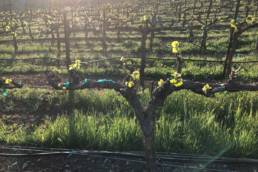FMN – October 2021 – Domestic Homage to “Old World” Wines
Although we use the terminology “old world” and “new world”, it truly is a misnomer. Some countries have produced wines for a thousand years, stopped producing (usually due to political environment) for multiple decades and started up again when the circumstances became more favorable. South Africa planted vines in the seventeenth Century, the same time the Dutch were draining the Medoc of Bordeaux, and yet they are considered New World. It’s confusing and frankly misdirected.
The phrases, I believe, were more about wine production techniques and philosophies rather than the area they came from. These lines have been blurred with new regions adopting some ancient techniques while the traditional values have loosened and integrated modern technologies. Both of these circumstances have benefitted the consumer and given us a broader range of styles and, in most cases, less flawed wine.
I try not to discriminate when it comes to comparing wine made from traditional winemaking countries and those with a more recent, emerging industry footprint. I do, however, find it intriguing to sample wines grown outside their “classic” regions. These wines, when fashioned by a quality-minded producer, can pay tribute to the traditional while showcasing new dimensions of possibility. As I’ve stated numerous times before, the ability of a winemaker to transcend the normal gives me great hope of the industry’s future; with the caveat that these wines need not be robbed of their varietal identity.
Domestically, we have varied levels of success with these “Old World” varieties. Granted we always seem to find the proper growing conditions that allows the vine to thrive. The winemaking, however, can be hit or miss with some Frankenstein wines manipulated to the point of being unrecognizable. Make no mistake, I’m not saying the winemakers are incompetent. Nor am I saying the wines are poor quality (though this does occur). Rather, some wines do not taste like they come from the variety we read on the label and with that I take exception.
The grape that seems to express stylistic decisions in the vineyard and winery is Pinot. To understand this grape, you need to first realize that all the Pinot family (Pinot Gris, Pinot Noir, Pinot Meunier, Pinot Blanc, etc.) are not separate varieties but rather mutations of the same variety. This vine has been lingering around for hundreds of years and been relocated to vineyards all over the world resulting in literally over one thousand different Pinot grapes. This genetic connection still manifests itself as an occasional black grape appearing in a white Pinot cluster and vise versa, which occurs more commonly than one would expect.
Pinot Gris/Grigio has been extremely popular as of late due to the northern Italian style of light, crisp and sometimes bracingly acidic, easy drinking wines. Some quality-minded winemakers do produce more interesting and complex versions while still remaining “Italian” in style. Other regions, like Alsace, produce viscous, complex Pinot Gris, often time with some residual sugar to balance that acidity. Two very different “Old World” styles that we see also expressed in many regions across our country.
There are some simple mass-produced high alcohol acid water versions coming out from the west coast. Likewise, some producers here have treated this grape with greater reverence but those are few and far between. Oregon, however, seems to have some of the most interesting domestic examples with many a proverbial amalgam of these two classic styles.
Although one of the most revered of the Pinots, Pinot Noir, has its spiritual home in the confines of Burgundy, it has found refuge in wine regions all over the world. The styles range from the classic forest floor (and sometimes Bretty) wines of Cote d’ Or to the crunchy red fruit (and sometimes insipid) wines of colder European regions. There even seems to be a popular style coming out of some of the hottest winegrowing regions (including the US), where the wines breakthrough the fifteen percent alcohol barrier and are as rich and dark as a Merlot. Although these wines can sometimes command high prices and have cult-like followings, sadly they are not Pinot Noir. There are some cooler areas of California and Oregon that pay homage to the earthy elements of the classic versions while extracting more complex fruit and spice aromatics. These winemakers that brave the pitfalls of this finicky variety are true artists and that is not to be understated.
Chenin Blanc is another grape variety that has a remarkable history in a multitude of different regions. Although Loire Valley seems to be some of the oldest plantings, this grape has thrived from the coastal regions of South Africa to the hottest areas of California. The reasons for the success of this variety are twofold. Even in the hottest of climates, this grape has the ability to maintain its natural acidity. Unfortunately, for this reason, much of the Chenin produced has been used to lift the acidity of other wines and relegated it to a secondary blending partner.
The versatility of the wines produced from this grape is another reason for its continued success. From dry to sweet and still to sparkling, all manner of styles seems to suit Chenin Blanc. This grape thrives at all different sweetness levels and produces some of the most unctuous and renown dessert wines in the world, rivaling even those of Sauternes. Although the domestic markets have not fully exploited its versatility, there are some producers that treat this grape with the respect it deserves and make some amazing varietal wines.
My final grape before I step down from my soapbox is Cabernet Franc. This misunderstood parent of Cabernet Sauvignon, Merlot, and Carménère has ancient roots (no pun intended) and has long been planted throughout Europe. Most notable in the Loire Valley as the most popular red variety and in the Right Bank of Bordeaux where it often plays second fiddle to its offspring Cabernet Sauvignon. One of the strengths of this Cabernet is the ability to grow in a much cooler climate, thus the reason for Right Bank, Southwest France, Loire and even Northern Italy plantings.
The grape has also made its mark in the United States, especially in these cooler growing regions, where most black grapes often struggle. New York, Michigan and even Canada all have successful examples but this grape quickly becomes overtly vegetal if under ripe or over cropped. Although still often used as a blending partner for other bolder domestic red wines, some winemakers have strived to make great varietal examples and these can be some of the sexiest ethereal wines you can imagine.
I do love some of the classic and traditional examples of these varieties, but there are many domestic winemakers that continue to do a tremendous job pushing the limits while producing these wines. Their ability to stay varietally true in addition to offering their own personal unique elements, makes many of these wines a joy to explore. In a time when much of the industry is moving dangerously toward a monoculture, producers like these may by our saving grace.
Suggested Wines:
Montinore Estate Pinot Gris 2019 Willamette Valley, OR $20
There are overt aromatics of citrus (pineapple), tropical (guava, kiwi), orchard fruit (pear) with a hint of grassiness. The dry palate has a vibrant, electric linear acidity with a medium palate and medium intensity. The gently warming alcohol remains in balance and has flavors of citrus (pineapple, lime), orchard fruit (green apple), and a hint of minerality. This wine lingers with a slightly sea-foam meeting tropical citrus finish. Pair this wine with lighter grilled fishes (trout), creamy cheeses (goat cheese), and grilled shrimp.
Folk Machine Chenin Blanc 2019 Clarksburg, CA $ 20
This wine has classic Chenin aromas of stone fruit (apricot), citrus (lime zest), floral (honeysuckle) and blossom (lime blossom). There is also a slight toast component that presents like a mixed fruit marmalade on freshly toasted bread. The palate has a slightly off-dry perception with broad crescendoing acidity and a medium plus mouthfeel. The palate is a bit more restrained with nuances of tropical citrus and stone fruit compote and the medium finish has an unsweetened lime curd type of feel. Pair this with brie, roast turkey, and baked ham.
Chehalem Pinot Noir 2019 Chehalem Mountain, OR $22
The slightly restrained nose has complex red fruit (strawberry, raspberry, cranberry), spice (white pepper and allspice) and a “leaf pile after a rain” earthy note. The palate is dry with crunchy acidity, medium body and evident fine grained sticky tannins. There are flavors of red fruit (cherry, strawberry), baking spice (all spice) and finishes with a slight toasted note. Pair this with wild mushroom risotto (porcini, morrells), quail, and country pate. These Oregonian Pinot Noirs are one of my guilty pleasures.
Hobo Camp Cabernet Franc Sonoma County, CA $22
You may think I’m crazy but this wine smells French. The nose has an elegant fruit component (mulberry, red currant, raspberry), sweet baking spice, earthy (dried tea leaves) and a very slight green peppercorn nuance. The dry palate has medium tangy acidity with sandy, slightly stalky tannins felt more on the gums. The flavors mirror the aromatics with even more pronounced earthy herbaceousness. This is one of the most elegant and restrained Cabernet Francs that I have ever had the distinct pleasure of tasting. Pair this wine with grilled lamb, slow roasted beef, and Moroccan dishes.




